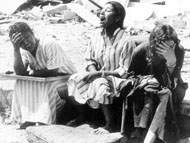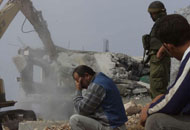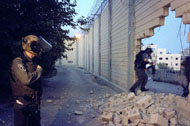September 16 marks the 25th anniversary of the massacre in the Sabra and Shatilla refugee camps in Lebanon. During the course of the two-day attack, a reported 2,000 Palestinians – mainly women, children and elderly - were slaughtered in their homes at the hands of the pro-Israeli Lebanese Maronite Phalangist militia under the direct eye of the occupying Israeli army. While Israel puts the death toll at 700, some Palestinian and Lebanese estimates put it as high as 3,500.
The massacre took place after the Israeli invasion of Lebanon in June, 1982, ostensibly in retaliation for the attempted assassination of an Israeli ambassador in London. The invasion, however, was widely perceived as an Israeli bid to drive out the PLO from Beirut, where it had set up its headquarters and where several PLO factions had established strongholds, especially in Palestinian refugee camps around the capital. At the time, Ariel Sharon was serving as Israeli Defense Minister and was later held responsible for the Sabra and Shatilla massacres.
Following two months of fierce fighting between Israeli, Lebanese and Palestinian forces, a ceasefire was reached, which entailed an evacuation of the PLO from Beirut. The PLO agreed to the ceasefire on condition that Palestinian civilians in the camps would be protected. The Americans, who helped broker the ceasefire, supposedly guaranteed this. The PLO was officially evacuated by September 1.
The refugee camps, previously protected by heavily armed members of Palestinian factions, were then left to their own devices. One day after international forces pulled out of Beirut, Sharon announced there were “2,000 terrorists left in the camps”. Then, on September 14, Israeli ally and Lebanese President-Elect Bashir Gemayal was assassinated. Gemayel was said to have met with Sharon days earlier and agreed to allow Lebanese Phalangist forces to “mop up” the Palestinian camps.
Then by September 16, the Israeli army had completely surrounded West Beirut, including the camps of Sabra and Shatilla and an order by the Israeli army high command was issued to allow the Lebanese army to “search and mop up” the camps.
That evening approximately 150 Philangist militiamen entered Sabra and Shatilla and for the next 40 hours proceeded to rape, torture and massacre hundreds of women, children and men in their homes and in front of their families. While the Israeli army did not have a direct hand in the actual killings, they were in full knowledge of the massacre. Not only did they do nothing to intervene, but they trained, fed and equipped the Phalangists, giving them the green light and a free hand to slaughter the Palestinians.
There has never been an exact final death toll because, in addition to the 1,000 or so bodies buried in mass graves, there were an unidentified number of bodies buried under the rubble of ruined homes. Also, Phalangist militiamen took truckloads of Palestinian men to unknown destinies, most of whom are still considered missing.
After the Lebanese army withdrew from Sabra and Shatilla, and the carnage left behind was broadcast in the media, Israeli public pressure led to a parliament-formed commission of inquiry into the massacre. The Kahan Commission would later find Sharon personally responsible for the massacre and would demand his resignation. Although Sharon did resign his post, he remained in government as Minister without Portfolio.
Renowned British journalist Robert Fisk visited the camps right after the massacre took place. In his description of the scene, he spoke of raped women, their skirts still torn off their thighs, children with their throats cut and babies already decomposing in the late-summer heat.
Head of the Phalange party at the time Elie Hobeika, did not hide his disdain for the Palestinians. He proudly announced that his militiamen employed the same methods of ethnic cleansing that Israel used during the 1948 war to drive the Palestinians out. “Shoot them against the pink and blue walls; slaughter them in the half-light of the evening," he said. "The only way you will find out how many Palestinians we killed is if they ever build a subway under Beirut...A good massacre or two will drive the Palestinians out of Beirut and Lebanon once and for all.”
Over the last quarter century, there have been attempts by human rights organizations to indict Ariel Sharon on behalf of the survivors of Sabra and Shatilla. The indictment, however, has never come to fruition and neither Sharon nor the Phalangist militia have ever been held fully accountable for the atrocities they perpetrated against the inhabitants of the Sabra and Shatilla camps in September, 1982.








